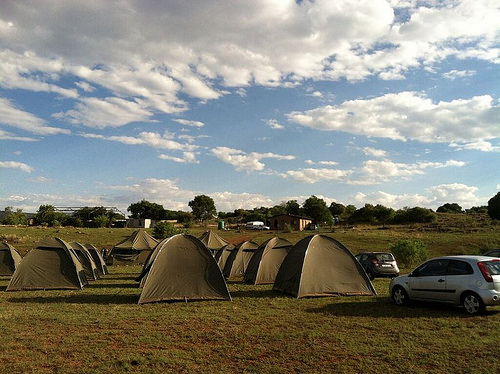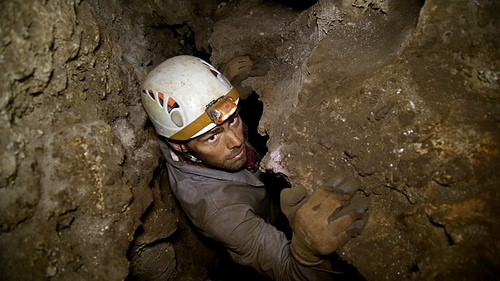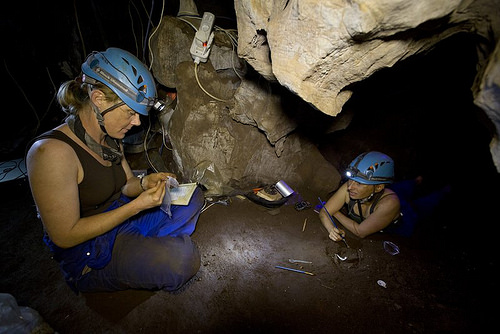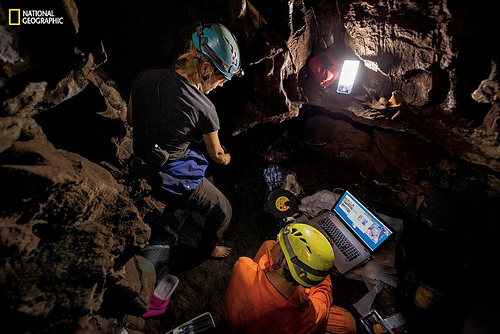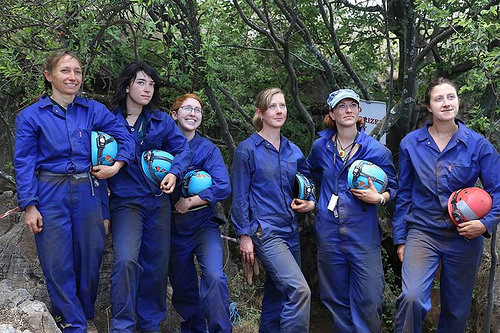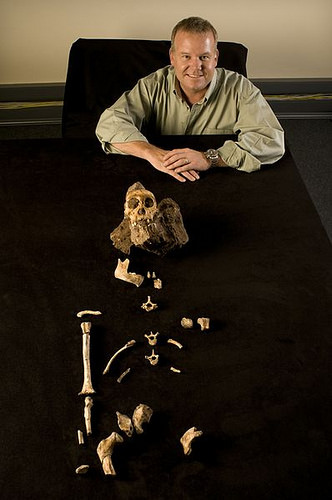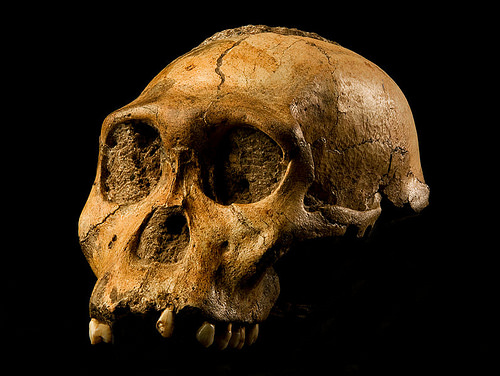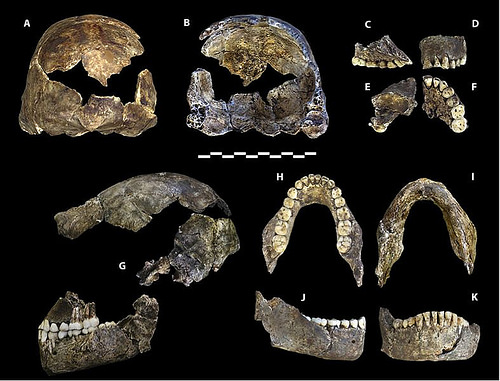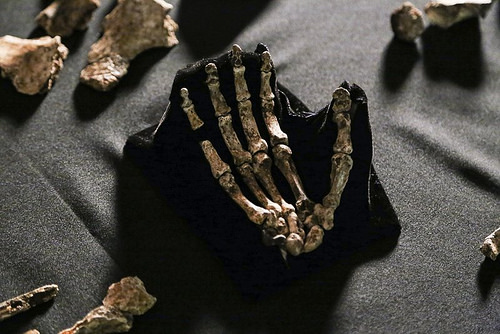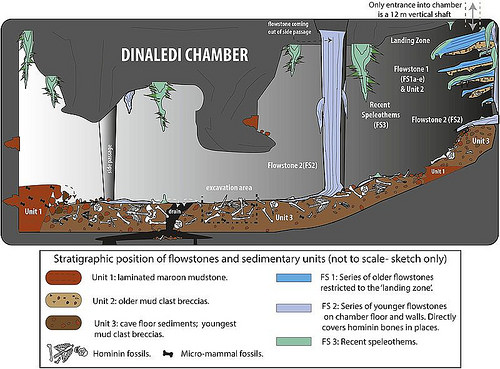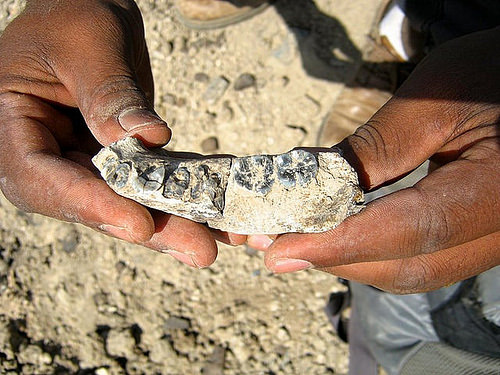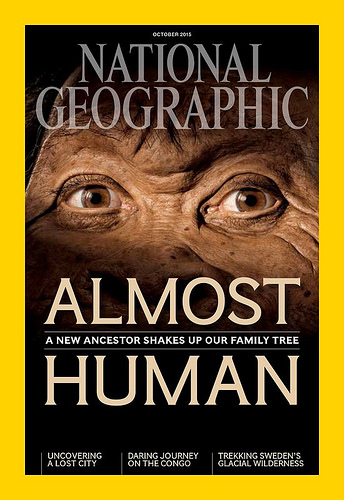They were having the time of their lives. No other excavation had ever come close.
By the Spring of 2014 they had uncovered more than 1,550 bones representing at least 15 ancient individuals from a small, dark, nearly inaccessible chamber about 30 meters underground in the “Rising Star” cave system in South Africa. Long a caving destination for spelunkers, the Rising Star system is part of a complex of limestone caves near what is called the “Cradle of Humankind”, a World Heritage Site in Gauteng province well known for critical paleoanthropological discoveries of early humans. But at any level, this particular discovery was an extremely rare event. Designated as the “Dinaledi Chamber”, the finds within have gone on record as the largest single assemblage of hominin fossils in any one location in Africa.
The Expedition
The story of this discovery really began with two cavers, Rick Hunter and Steven Tucker, who found the entrance to the Dinaledi Chamber and discovered the fossils. The fossils were thought at the time to be the remains of a single individual. They showed pictures of the fossils to Pedro Boshoff, another caver and geologist. Recognizing the fossils as potentially significant, Boshoff alerted Professor Lee Berger of the University of the Witwatersrand, who then spearheaded the assembly of an expeditionary group (called the “Rising Star Expedition”) of scientists.*
On November 10, 2013 the first of these explorers entered the chamber, initiating the first of two expeditionary efforts, the first lasting about 21 days and the second, in early 2014, lasting about one week. Discovering very early that the cache of bones was far larger than they had ever imagined, in addition to being very difficult to reach, they realized that their task would not be an easy one. Carefully excavating the fossil elements with tools as delicate as toothpicks and brushes, they gently removed the fossils, piece by piece, and transported them up through the narrow 7.5-inch chute, including a second narrow area called the ‘superman’s crawl’ only 10 inches wide, to the surface. More than 60 cavers and scientists worked together in what Marina Elliott, one of the excavating scientists, described as “some of the most difficult and dangerous conditions ever encountered in the search for human origins”. Elliott was one of six women selected as “underground astronauts” from a global pool of candidates after Berger issued a call on social media for experienced scientist/cavers who could fit through the 18-centimeter cave opening. To facilitate safety, support and critical communication and observation of the excavation operation deep below, Berger employed efforts to design and install a network of safety lines, lights, cables and cameras to support the cave explorers and keep the senior scientists at the surface connected to their front-line “underground astronaut” scientists below. With the successful recovery of well over a thousand skeletal elements, the execution and results of the operation turned out to be far beyond anything they had ever expected.
Social media continued to play a role in the project, as the team shared expedition progress with a large public audience, schoolchildren and scientists. “This was a first in the history of the field,” said John Hawks, a paleoanthropologist with the University of Wisconsin-Madison who co-led the expedition and worked with Berger to design the media outreach.
The fossils were subsequently analyzed in a unique workshop in May 2014 funded by the South African DST/NRF, Wits University and National Geographic. More than 50 experienced scientists and early-career researchers came together to study and analyze the treasure trove of fossils and to compose scientific papers.
_____________________________________________________________
Caver Steven Tucker squeezes through a narrow passage in the Rising Star cave. Tucker was one of the cavers on Lee Berger’s exploration team who found the chamber. The finds were announced by the University of the Witwatersrand, the National Geographic Society and the South African National Research Foundation and published in the journal eLife. Photo by Garrreth Bird
____________________________________________________________
“Underground astronauts” Marina Elliott and Becca Peixotto work inside the cave where the fossils were discovered. The finds were announced by the University of the Witwatersrand, the National Geographic Society and the South African National Research Foundation and published in the journal eLife. Photo by Garrreth Bird
________________________________________________________________
Anthropologist Marina Elliott (left) and paleontologist Ashley Kruger working inside the cave system. National Geographic Explorer-in-Residence Lee Berger of the University of the Witwatersrand (pictured on the computer screen) led the expedition and followed the progress inside the cave from the surface. From the October issue of National Geographic magazine. Photo by Elliot Ross/National Geographic
______________________________________________________________
The “underground astronauts” (left to right): Becca Peixotto, Alia Gurtov, Elen Feuerriegel, Marina Elliott, K. Lindsay (Eaves) Hunter and Hannah Morris. The team of scientists excavated the chamber. The finds were announced by the University of the Witwatersrand, the National Geographic Society and the South African National Research Foundation and published in the journal eLife. Photo by John Hawks
________________________________________________
Berger’s Fortune
Even before the Rising Star expedition, Berger was no stranger to breakthrough discoveries. Several years before Rising Star was on his radar screen, he and his then 9-year-old son Matthew stumbled upon unprecedented finds at the fossil bearing site of Malapa, also in South Africa only 10 miles away from the Rising Star site. The finds consisted of remarkably complete skeletal remains as well as other well-preserved fauna and flora, instantly becoming some of the most intensely and thoroughly studied hominin fossils ever documented. Dominating science headlines when the news was first released, the discovery of more than 300 skeletal remains, including parts of skeletons still encased in rock, revealed a very ancient hominin candidate that sported a mosaic of features both ape-like and human—a 2-million-year-old hybrid called Australopithecus sediba (Au. sediba). The research team, led by Berger and composed of South African and international scientists from the Evolutionary Studies Institute (ESI) at the University of the Witwatersrand (Wits) and 16 other global institutions (totalling more than 100 researchers from around the world), examined the anatomy of Au. sediba based on its skeletons catalogued as “MH1” (a juvenile skeleton named “Karabo”)) and “MH2” (an adult female skeleton), as well as an adult isolated tibia catalogued as “MH4”. Dispersed among separate studies, the research determined, more than any other Australopithecus findings to date, the essence of how this hominin looked, walked, chewed and moved, complicating and changing perspectives on the evolution of the australopith forerunner genus in human ancestry.
__________________________________________________
The cranium of Malapa hominid 1 (MH1) from South Africa, named “Karabo”. The combined fossil remains of this juvenile male is designated as the holotype for Australopithecus sediba. Photo by Brett Eloff. Courtesy Lee Berger and Wits University.
__________________________________________________________________
But as Berger would soon discover, Malapa would be relinquishing its crown to Rising Star………
__________________________________________________
A new species
So what was this new Rising Star team of scientists looking at? Were they bones of the same species discovered years earlier at Malapa?
Preliminary analysis told them they were not.
Finally, after months of concerted, intense examination, they made their announcement on September 10, 2015……….and like the Malapa discovery, they concluded that what they had before them was an entirely new species of hominin. They called this one Homo naledi. And like Australopithecus sediba before, the combination of anatomical features was unlike any previously known species.
“Overall, Homo naledi looks like one of the most primitive members of our genus, but it also has some surprisingly human-like features, enough to warrant placing it in the genus Homo,” said Hawks, who was also a senior author of the research paper describing the new species. “H. naledi had a tiny brain, about the size of an average orange, perched atop a very slender body.” The research shows that on average H. naledi stood approximately 1.5 meters (about 5 feet) tall and weighed about 45 kilograms (almost 100 pounds).
A gracile creature with a brain not much larger than a chimpanzee.
But this was no chimpanzee. This was something else. Something more human.
According to the examining scientists, this creature had teeth and skull features similar to those of the earliest-known members of our genus, such as Homo habilis. Certain key features of the hands, particularly the thumb, wrist and palm, suggested “tool-using capabilities”, according to Dr. Tracy Kivell of the University of Kent, U.K., a leading member of the team that studied H. naledi’s anatomy. And the feet were even more telling. Other than a few notable characteristics, they were “virtually indistinguishable from those of modern humans,” said Dr William Harcourt-Smith of Lehman College, City University of New York, and the American Museum of Natural History, who led the study of H. naledi’s feet. Its human-like ankles and feet, combined with its long lower limbs, he suggested, indicated that the species was well-suited for upright, long-distance walking—just like us. These were all trademark traits attributable to humans.
But there were clearly more “primitive”, ape-like traits, as well. The much smaller brain, for one. The shoulders were similar to those of apes, and like apes, the fingers of the hand had “extremely curved fingers, more curved than almost any other species of early hominin, which clearly demonstrates climbing capabilities,” said Kivell—features that facilitated a tree-climbing life. Moreover, this creature exhibited a short, ape-like torso and the pelvis resembled that of an Australopithecine, a more ape-like protohuman relative, fossils of which have now long been a part of the broad range of hominin finds in Africa.
________________________________________________
From the eLife report: Holotype specimen of Homo naledi, Dinaledi Hominin 1 (DH1). Berger et al., 2015 http://elifesciences.org/lookup/doi/10.7554/eLife.09560.019
___________________________________
Skeletal fossils of the hand of Homo naledi pictured in the Wits bone vault at the Evolutionary Studies Institute at the University of the Witwatersrand, Johannesburg, South Africa, on Sept. 13, 2014. The fossil hand is one of many fossils representing a new species of hominin. The broad thumb of Homo naledi suggests it was an expert climber. The Rising Star Expedition, a project that retrieved and analyzed the fossils was led in part by paleoanthropologist John Hawks, professor of anthropology at the University of Wisconsin-Madison. Photo by John Hawks/University of Wisconsin-Madison
_____________________________________________________________
Homo naledi foot. Berger et al., http://elifesciences.org/content/4/e09560
_______________________________________________
An ancient repository for the dead?
Perhaps most significantly, study of the context of the finds has led the researchers to conclude that H. naledi may have practiced a form of behavior previously thought to be unique to later humans. The fossils, consisting of infants, children, adults and elderly individuals, were found in a deep underground room that has “always been isolated from other chambers and never been open directly to the surface,” said Dr Paul Dirks of James Cook University in Queensland, Australia, lead author of the eLife paper on the context of the find. “What’s important for people to understand is that the remains were found practically alone in this remote chamber in the absence of any other major fossil animals.”
So remote was the space that out of more than 1,550 fossil elements recovered, only about a dozen are not hominin, and these few pieces are isolated mouse and bird remains, meaning that the chamber attracted few accidental visitors. The bones show no marks of scavengers or carnivores or any other signs that non-hominin agents or natural processes, such as moving water, carried these individuals into the chamber. Moreover, there was no evidence that the chamber was ever used as an actual living space by humans, and the age ranges of the skeletons fit the pattern of what archaeologists find in cemeteries. “We explored every alternative scenario, including mass death, an unknown carnivore, water transport from another location, or accidental death in a death trap, among others,” said Berger. “In examining every other option, we were left with intentional body disposal by Homo naledi as the most plausible scenario.” This suggests the possibility of a form of ‘ritualized’ behavior previously thought to be unique to humans (“ritualized” meaning repeated behavior.) “It seems probable that a group of hominins was returning to this place over a period of time and depositing bodies,” Hawks explains, adding that the supposition is akin to discovering similar behavior in chimpanzees. “It would be that surprising.” Furthermore, the way the bodies are arranged and their completeness suggests they were carried to the cave intact. “The bodies were not intentionally covered and we’re not talking about a religious ceremony, but something that was repeated and repeated in the same place. They clearly learned to do this and did it as a group over time. That’s cultural. Only humans and close relatives like Neandertals do anything like this.”
Still, there are remaining mysteries: Given that this deep, dark, isolated chamber likely could only be accessed with the aid of mobilized light sources, does this mean that this small-brained early human could control fire? And even though it is clearly feasible for small individuals to negotiate the narrow chutes to reach the chamber, could they have done this while carrying or managing a dead body to deposit into the chamber? We have now seen how difficult it is for a modern spelunker or scientist to reach the chamber, even without the burden of carrying or pulling a lifeless body. Why would these hominins have gone through so much trouble?
According to the site investigators, there are more layers of deposition to excavate and many more bones to be recovered. Perhaps some answers are still hidden within the chamber.
_______________________________________________
Illustration of the geological and taphonomic context and distribution of fossils, sediments and flowstones within the Dinaledi Chamber. The distribution of the different geological units and flowstones is shown together with the inferred distribution of fossil material. The fossils came into the cave at the time of the deposition of the unit 1, 2 & 3 sediments via the chamber entrance at top right. Unit 1 represents early sediments which contain only some rodent fossils. Unit 2 represents sediments attached to side wall by flow stone, i.e. remnants of early deposits that do contain fossil bones of Homo naledi. Unit 3 represents rubble sediments containing most fossil bones. Paul H. G. M. Dirks et al., http://elifesciences.org/content/4/e09561
_______________________________________________________________
The million dollar question: How old?
Now that scientists have discovered this new hominin species, what about the age?
Dating the finds has been problematic for a number of reasons. First, unlike other fossil deposits in caves, these fossils were found with very few or no fossils of other animals that could be directly associated with the finds, making it impossible, for now at least, to determine a faunal age. Secondly, the few flowstones in the cave that can be directly linked to the fossils are contaminated with clays, making them very difficult to date. Moreover, the fossils are contained in soft sediments that have been partly re-worked and re-deposited by acts of nature over time, making it extremely difficult to establish their primary stratigraphic position.
“We have tried three approaches that have failed to give dates for the actual fossils, and are currently working on further attempts,” report Berger and the scientific team. “Because of the uniqueness of the fossils and the situation in which they are found, we only want to publish age limits for them when we are absolutely sure that they are right.”
Thus the consensus at this point is that it is anybody’s guess. “They could have been there 2 million years ago or 100,000 years ago, possibly coexisting with modern humans,” said Hawks.
One hope, says Hawks, is finding the remains of an animal that may have been a contemporary of Homo naledi. The fossils are embedded in a matrix of soft sediment and there are layers that remain unexcavated.
Nevertheless, given the geographic context with proximity to other already dated caves in the area, such as Sterkfontein, Swartkrans, and Malapa, the scientists suspect that the Dinaledi cave system may fall within the 2-to-3-million-year-old time range, possibly placing H. nadeli near or at the root of the genus Homo, considering the morphology. [To complicate the picture, however, one recent study conducted by researchers at Simon Frazer University suggests that Homo naledi may be about 912,000 years old, one million years younger than earlier speculations].
__________________________________________________
H. naledi’s place in the human family
Without a solid range of dates, the Rising Star scientists would likely be the first to say that any conclusions about where H. naledi falls within the human family universe would be tentative at best. Looking purely at the morphology, however, a number of skeletal features show clear markers that (many scientists agree) point to Homo. But combined with H. naledi’s significant ape-like characteristics, not the least of which is a small brain, a murky picture emerges. If indeed H. naledi is Homo, then, morphologically speaking, she could well stand at the cusp within the transition between the more ‘primitive’ Australopithecines and the more ‘human’ Homo genus species, such as Homo erectus.
But the first Homo?
Several hominin candidates have already been advanced for this honor by some scientists. Homo habilis is perhaps the best known. Dated generally within the range of 2.4 and 1.4 million years ago, fossil fragments of this species were first recovered by a team led by Louis and Mary Leakey in the early 1960’s at Olduvai Gorge, Tanzania. A few other habilis finds followed in different East African locations in the ensuing years. Featuring a slightly larger braincase and a smaller face and teeth, unlike an Australopithecus, but long arms and a prognathic facial form, like an Australopithecus, it appeared to straddle the line between the Homo and Australopithecine genus, with perhaps a tilt toward Homo. It was officially classified into the Homo genus, and touted by some as the first Homo. Not all scientists agree, however, and there are those who favor placing habilis squarely in the Australopithecine camp.
Another very early fossil candidate, a mandible excavated by German paleoanthropologist Friedermann Shrenk at Uraha, Malawi in 1991, also featured clear signs of Homo. It was classified as belonging to the species Homo rudolfensis and, with a date of 2.4 million years, became the oldest known evidence for Homo, adding to some claims that the species coexisted with habilis as a contender for the earliest Homo throne.
But the game changed again when, in January, 2013, Arizona State University’s Kaye E. Reed and colleagues unearthed a partial hominin mandible in the Ledi-Geraru area of the Afar region of Ethiopia. Pushing back the clock with a date of about 2.8 million years BP, it was a 8-cm.-long mandible with five intact teeth, representing the left side of a lower jaw. It revealed features such as slim molars, symmetrical premolars and an evenly proportioned jaw, characteristics that have distinguished species of the Homo lineage. Yet it also featured characteristics such as a more primitive, sloping chin morphology, similar to that of the Australopithecines.
Homo or Australopithecus? These scientists suggest Homo.
“We have a jaw with teeth that preserves enough anatomy to be quite confident that it does represent an early part of the Homo lineage,” said team member William H. Kimbel of ASU’s Institute of Human Origins.
The species? Not enough material to make such a decision, says Reed and her colleagues. But the find has implications for understanding that mysterious transitional period between Australopithecus and Homo.
“There are relatively few fossils that can inform us about the origins of the genus Homo,“ said research team leader Brian Villmoare. “However, this is one of the most interesting periods in human evolution, because during this poorly-known period, humans made the important transition from the more ape-like Australopithecus to the more modern adaptive pattern seen in Homo.”
“We’re beginning to narrow the time,” added Kimbel, “not only as to the origin of the Homo lineage, which now predates 2.8 million, but to the time when it is likely that separate lineages of early Homo could have evolved…….the precise nature of the transition, for example whether it was a gradual transformation along a lineage, or a rapid divergence of lineages, or whether the early changes in the teeth and jaws were accompanied by changes in other systems, such as brain, or technology—these things are unknown still.”
And now we have H. naledi. But no dates.
Dating aside, however, the scientists have nevertheless reached some interesting suggestions about where H. naledi might fit into the picture of human evolution and how the evolutionary process has worked.
“We propose the testable hypothesis that the common ancestor of H. naledi, H. erectus, and H. sapiens shared humanlike manipulatory capabilities and terrestrial bipedality, with hands and feet like H. naledi, an australopith-like pelvis and the H. erectus-like aspects of cranial morphology that are found in H. naledi,” write the researchers in their report. Moreover, they continue, “enlarged brain size was evidently not a necessary prerequisite for the generally human-like aspects of manipulatory, locomotor, and masticatory morphology of H. naledi.”**
So what would be the implications in terms of their place in evolutionary history if reliable dating could be achieved?
“If the fossils prove to be substantially older than 2 million years, H. naledi would be the earliest example of our genus that is more than a single isolated fragment,” write the researchers. On the other hand, “a date younger than 1 million years ago would demonstrate the coexistence of multiple Homo morphs in Africa, including this small-brained form, into the later periods of human evolution.”**
Either scenario, according to Berger’s team, would be big news.
But whether or not further study and testing reveals that H. naledi falls within that 2-to-3-million-old transitional time range, there is no doubt that the picture becomes all the more complex. The long list of questions about human evolution expands.
_____________________________________________________
Close-up view of the Ledi-Geraru partial mandible close to where it was sighted. Credit: Kaye Reed
_____________________________________________________
Going forward
Berger and his team conclude, as they did at the discovery of Australopithecus sediba in 2008, that there are clearly other key transitional forms of hominins that may yet be discovered and added to the fossil record. The developing picture, in other words, may be enormously complex, with the possibility of a multitude of various hominin species with different combinations of both “primitive” and “derived” (more modern) characteristics, inhabiting the same regions in overlapping periods of time and perhaps even interbreeding, creating what Berger has described as a “braided stream” through time to Home sapiens (modern humans), as opposed to the simpler, linear model advanced by earlier scientists.
For now, much remains to be discovered in the Rising Star cave. “This chamber has not given up all of its secrets,” Berger said. “There are potentially hundreds if not thousands of remains of H. naledi still down there.”
According to Hawks, years of work remain at the site, including continuing analysis and documentation of all of the materials excavated. Plans, he says, include bringing many new technologies to bear on analyzing the fossils to help determine diet, rate of aging, and where they lived on the landscape.
Readers can learn more about H. naledi in the detailed study reports in eLife, and by watching the video below.
_________________________________________________________
*Lee Berger of the Evolutionary Studies Institute, University of the Witwatersrand (Wits University), led the international team of scientists under the joint sponsorship of Wits, the National Geographic Society, and the South African Department of Science and Technology/National Research Foundation.
**Lee R. Berger et al., Homo naledi, a new species of the genus Homo from the Dinaledi Chamber, South Africa, eLife 2015;4:e09560. DOI: 10.7554/eLife.09560.
_________________________________________________________
_________________________________________________________
The discovery was featured as the cover story of National Geographic magazine’s October 2015 issue. The NOVA/National Geographic Special, “Dawn of Humanity,” premiered September 16, 2015, at 9 p.m. ET/8 p.m. CT on PBS in the United States and is streaming online now.
In the cover photo (left), paleoartist John Gurche used fossils from a South African cave to reconstruct the face of Homo naledi, the newest addition to the genus Homo. Photo by Mark Thiessen/National Geographic
See more videos about this discovery like the one shown in this article at PBS.org at http://www.pbs.org/wgbh/nova/evolution/dawn-of-humanity.html.
The research was supported by Wits University, the National Geographic Society and South African DST/NRF. Ongoing exploration and conservation of the Rising Star site is supported by the Lyda Hill Foundation.
Portions of this article were adapted and edited from sections of subject press releases of the University of the Witwatersrand, New York University, and the University of Wisconsin, Madison.
Top image above: Campsite in South Africa where National Geographic Explorer-in-Residence Lee Berger of the University of Witwatersrand led an expedition to recover the remains of H. naledi, a new species of human relative. The find was announced by the University of the Witwatersrand, the National Geographic Society and the South African National Research Foundation and published in the journal eLife. Photo by Andrew Howley/National Geographic
Image, 7th from top, right: Lee Berger with the partial skeleton of Australopithecus sediba. Photo by Brett Eloff, courtesy Lee Berger and the University of the Witwatersrand.
Cover Image for this article: Photo by Mark Thiessen/National Geographic
_________________________________________________________

